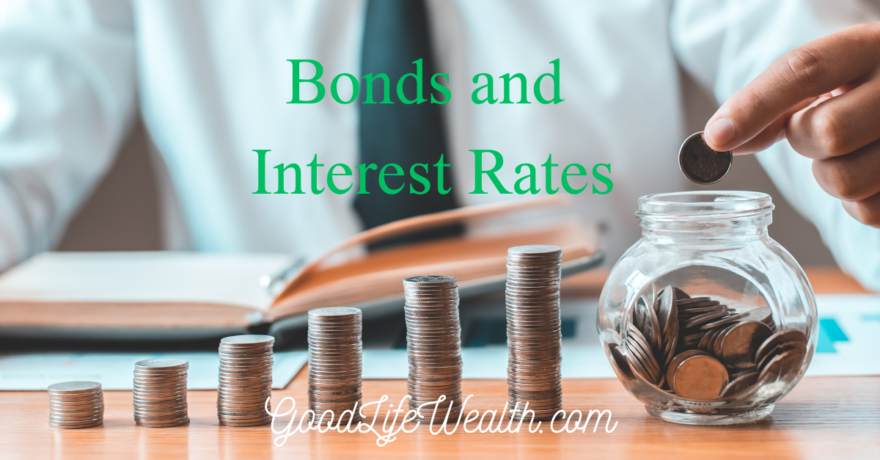How are Bonds and Interest Rates correlated? Bonds move inversely from Interest Rates. When rates rise, the price of bonds fall. This simple fact led to the downfall of Silicon Valley Bank and Signature Bank this month. Banks invest your deposits in bonds and earn a spread on the difference between what they pay you and the bonds they buy. Banks are not vaults with piles of cash – they are bond investors. That is their business model.
In 2020, these banks bought long-term bonds with yields of 1-2 percent. Fast forward to 2023, and yields are now 4-5 percent on the same bonds, and some of those bonds are now trading at 90 cents on the dollar. A bank with $10 Billion in these bonds now has a paper loss of $1 Billion.
If they can hold to maturity, these bonds will return back to their full value. But if a large number of depositors all want their money out today, the banks have to sell their bonds for a huge loss. And if that loss is large enough, the bank becomes insolvent and doesn’t have enough assets to cover their deposits.
Bank Failures
When a bank fails, the FDIC steps in and seizes the bank. What is remarkable about these two bank failures in March is the size of the losses. These two banks represent $319 Billion in assets, which makes 2023 the second worst year ever for the FDIC, and it’s only March. In 2008, bank failures totaled $373 Billion in assets. So it is easy to see how bad things could get in 2023, if two bank failures in March almost reached the losses of the Global Financial Crisis of 2008.
These banks are collateral damage from rising interest rates, thanks to the Federal Reserve. The Fed held rates for too low for too long after the start of the pandemic, and helped create the accelerating inflation. Now they are raising rates to slow the economy.
While the Federal Reserve did set this in motion, the poor risk management at the Banks should bear the brunt of the blame. We have been talking for several years about reducing the duration of our bond holdings and lowering our interest rate risk. And I thought everyone else was doing the same, it seemed pretty obvious to me. But no, there were banks buying these long bonds which were just waiting to get crushed. When customers realized the size of bank losses, they pulled their deposits and there was a run on the bank. Could other banks follow? Maybe. If customers pull out their deposits en mass, it is possible.
I am not terribly concerned about this spreading to other banks, because the Fed has launched a new program. The Bank Term Funding Program will provide loans to banks so that they can hold on to their longer dated Treasury bonds and not have to sell for a loss. It will provide liquidity so that the banks can hold these bonds for longer. And like other government programs, I can see this program being expanded and made permanent.
It is remarkable to me how much of our news today has its roots in bonds and interest rates. The bank crisis, inflation, recession, unemployment, retirement programs, real estate and mortgages, etc. These are all linked. What should the individual investor do? Here are our thoughts:
FDIC Coverage
I would never have more than $250,000 at any bank and exceed the FDIC coverage limits. I heard about a corporate subsidiary that had tens of millions at SVB, which failed last month. Luckily, it looks like the FDIC has arranged for all of those large account holders of SVB to be made whole. But I would not just assume that FDIC coverage is now unlimited. Instead of exceeding FDIC limits:
- You could use more than one bank and stay under FDIC limits.
- We can buy brokerage CDs from multiple banks in your Ameritrade account. Each issuer will carry $250,000 of FDIC coverage. Today we have 6-month CDs at 5%. Investors are often surprised that I can show them much better yields from Chase or Wells Fargo than they can get at their local branch.
- Ladder Treasury Bills. There are maturities every week. Treasury bonds are high quality and the most liquid market in the world.
Bond Strategies
Our core holdings for bonds consist of owning individual bonds laddered from 1-5 years. We buy investment grade bonds including Agency Bonds, Treasuries, Corporate, Municipal, and CDs. Today, the yield on Agency bonds is very competitive with Corporates. And CDs are yielding higher than Treasuries.
With today’s yields, I would avoid taking on significant credit risk. We are not buying any junk bonds, and have sold our Floating Rate bonds. In addition to rising interest rates, we are seeing liquidity problems in some areas of the bond market. It may become difficult or impossible for some low credit quality companies to refinance their debt in 2023 and 2024. It is probable that defaults will rise, another casualty of the Federal Reserve heading the economy towards a likely recession.
Inverted Yield Curve
While the Fed raised the Fed Funds rate 0.25% at their March meeting, the bond market moved the opposite direction. Over the past month, the 2-year Treasury has actually fallen from 4.89% on March 1, to as low as 3.76% on March 23rd. The bond market remains inverted, with the 2-year yields higher than the 10-year yields. This is a strong historical predictor of recession. The bond market is priced as if the Federal Reserve will begin cutting interest rates in 2023, which is not what Jerome Powell is saying at all. The Fed’s commentary shows that they anticipate raising rates to 5.10% (from the current 4.75-5.00%) by year end. The movement in the bond market is bearish for the economy and stocks.
So now there is the potential for the opposite movement of the bond see-saw. If rates do go down this year or next, bond prices will rise. If we enter a recession, investors will want to shift towards safety and the Fed will lower rates. This would be a good time to have longer duration bonds with higher credit quality. And so we have begun buying longer bonds, 7-15 years. And if nothing happens and we just hold these bonds, we have yields to maturity of 6%. That is also a good outcome, an alternative to stocks, which have a similar expected return today.
In spite of seeing losses in bonds in 2022, looking forward, bond returns look strong. Still, it is crucial to be mindful of the risks and to take steps to mitigate them. Here are some additional ways to improve safety in a bond portfolio:
Diversify Across Different Types of Bonds
It’s important to diversify across different types of bonds, such as corporate, municipal, and government bonds, as well as across different industries and sectors. This can help reduce the impact of any one bond issuer or industry experiencing difficulties.
Consider Active Bond Management
Active bond management can help adjust the portfolio to changing market conditions and credit risks. It may be worth considering investing in low-cost actively managed bond funds or working with an investment advisor who specializes in bond management.
Monitor Interest Rate Risks
Investors should keep a close eye on interest rate risks and how they may impact their bond portfolio. The longer the duration of the bond, the greater the impact of interest rate fluctuations. Investors may want to consider laddering their bonds to manage interest rate risks.
Use Credit Ratings as a Guide
Credit ratings can provide a guide to the creditworthiness of a bond issuer. Investors should be wary of bonds with lower credit ratings, as they may carry higher risks of default. However, it’s important to remember that credit ratings are not infallible and can sometimes be inaccurate.
In conclusion, while bonds can offer attractive yields and provide diversification to a high net worth investor’s portfolio, it’s important to be mindful of the risks and take steps to mitigate them. By diversifying across different types of bonds, actively managing the portfolio, monitoring interest rate risks, and using credit ratings as a guide, investors can help reduce their exposure to potential losses. Keeping cash in a bank may not be as safe as you might assume, especially if you exceed FDIC coverage. And why have cash earning next to nothing when you could be making 4-5% in short term CDs or Treasury Bills?
Within our strategic asset allocation models, we actually spend more time on managing our bond holdings than our stock holdings. Why? Because it’s that important, and it is an area where we believe we can add more value with our time. Interest Rates are in the news and there are a lot of risks today. Risk is often defined as a danger, but risk can also mean opportunity. We are seeing both dangers and opportunities in 2023, and you can bet there will continue to be a lot of headlines about Bonds and Interest Rates.





